Jesus and the Gospels Lesson 4
Matthew I
Mike Ervin
Jesus and the Gospels
After examining the Gospel of Mark as literature, we now move onto Matthew.
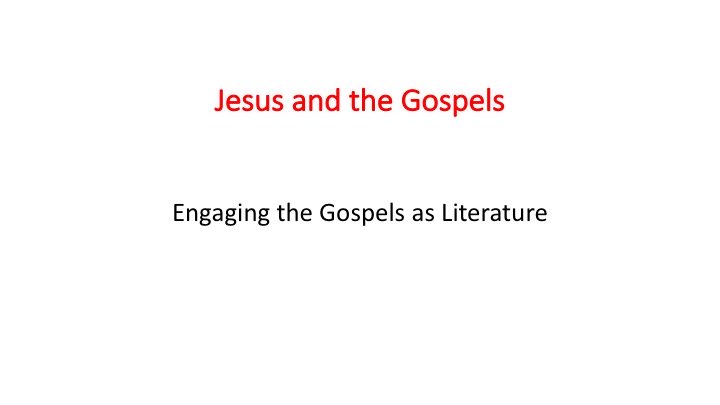
Jesus and the Gospels
Engaging the Gospels as Literature
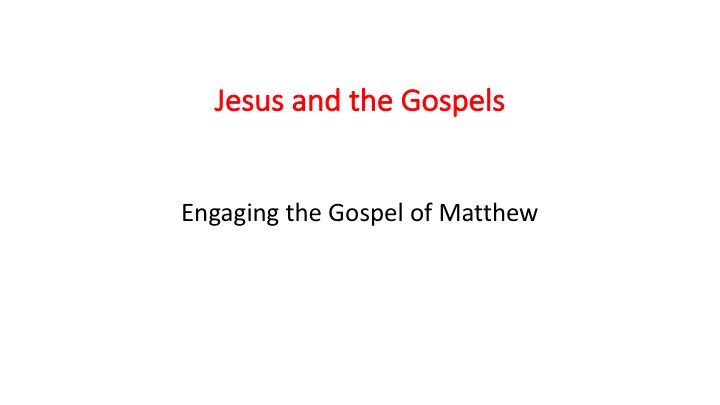
Jesus and the Gospels
Engaging the Gospel of Matthew
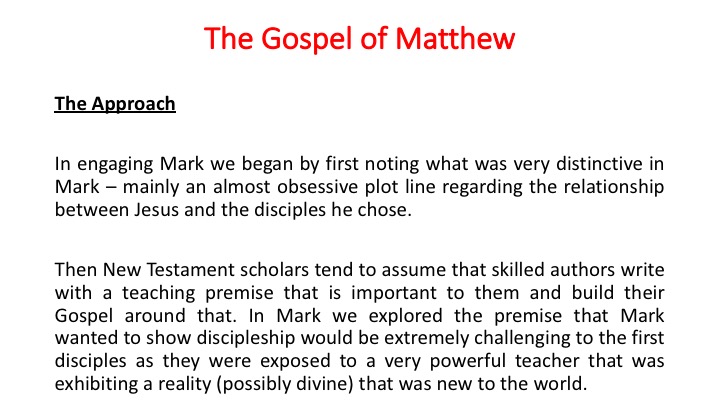
The Gospel of Matthew - Jesus and the Gospels
The Approach
In engaging Mark we began by first noting what was very distinctive in Mark – mainly an almost obsessive plot line regarding the relationship between Jesus and the disciples he chose.
Then New Testament scholars tend to assume that skilled authors write with a teaching premise that is important to them and build their Gospel around that. In Mark we explored the premise that Mark wanted to show discipleship would be extremely challenging to the first disciples as they were exposed to a very powerful teacher that was exhibiting a reality (possibly divine) that was new to the world.
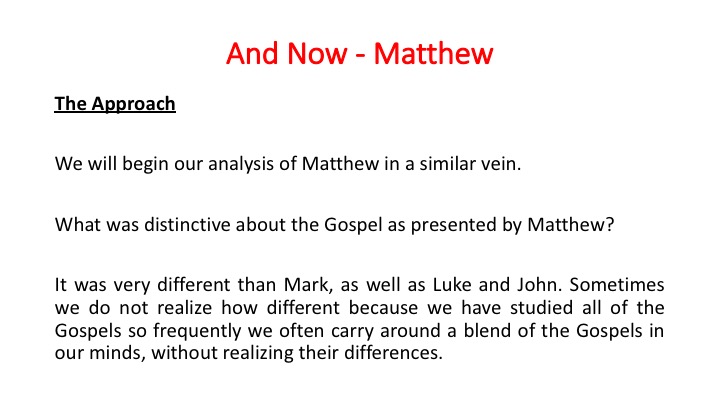
And Now – Matthew
The Approach
We will begin our analysis of Matthew in a similar vein.
What was distinctive about the Gospel as presented by Matthew?
It was very different than Mark, as well as Luke and John. Sometimes we do not realize how different because we have studied all of the Gospels so frequently we often carry around a blend of the Gospels in our minds, without realizing their differences. In effect we tend to have a Diatessaron of the Gospels in our mind rather than a clear understanding of the differences in the Gospels. Let's look at a simple example.
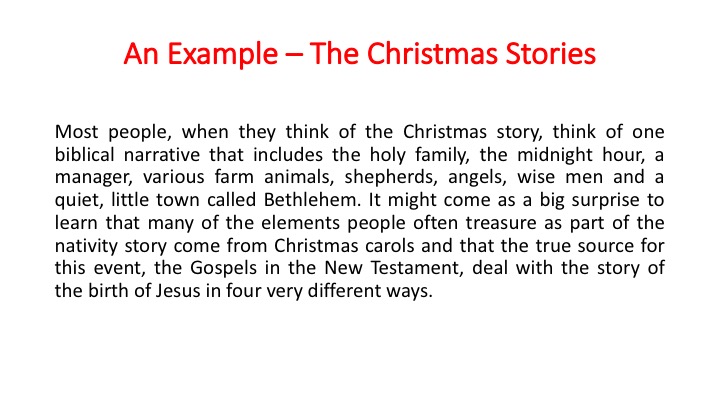
Jesus and the Gospels
An Example – the Christmas Stories
Most people, when they think of the Christmas story, think of one biblical narrative that includes the holy family, the midnight hour, a manager, various farm animals, shepherds, angels, wise men and a quiet, little town called Bethlehem. It might come as a big surprise to learn that many of the elements people often treasure as part of the nativity story come from Christmas carols and that the true source for this event, the Gospels in the New Testament, deal with the story of the birth of Jesus in four very different, but yet not contradictory, ways.
If you read Matthew for example, there is no midnight hour, no manager, nor farm animals, no shepherds. In Luke there are no wise men from the east. In Matthew the holy family has to escape to Egypt to avoid the baby Jesus being killed by Herod. Never happens in Luke. And we could go on. But as we will see as we delve more into this, Matthew needed the escape to Egypt and later return to Israel to strengthen his message, and Luke needed the wise men for his message.
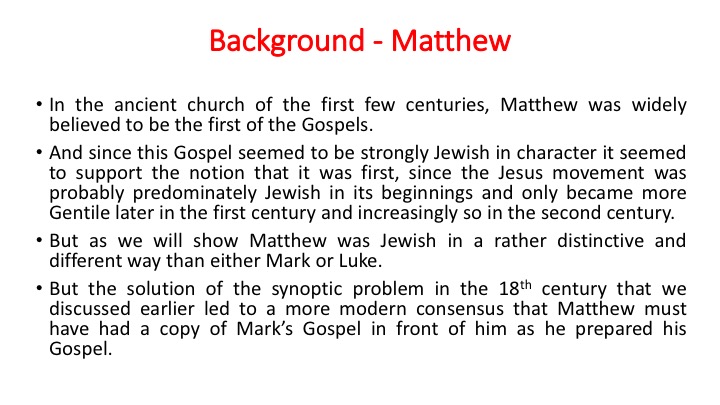
So let's start with some background information to Matthew.
Background – Matthew
In the ancient church of the first few centuries, Matthew was widely believed to be the first of the Gospels.
And since this Gospel seemed to be strongly Jewish in character it seemed to support the notion that it was first, since the Jesus movement was probably predominately Jewish in its beginnings and only became more Gentile later in the first century and increasingly so in the second century.
But as we will show Matthew was Jewish in a rather distinctive and different way than either Mark or Luke.
But the solution of the synoptic problem in the 18th century that we discussed earlier led to a more modern consensus that Matthew must have had a copy of Mark’s Gospel in front of him as he prepared his Gospel.
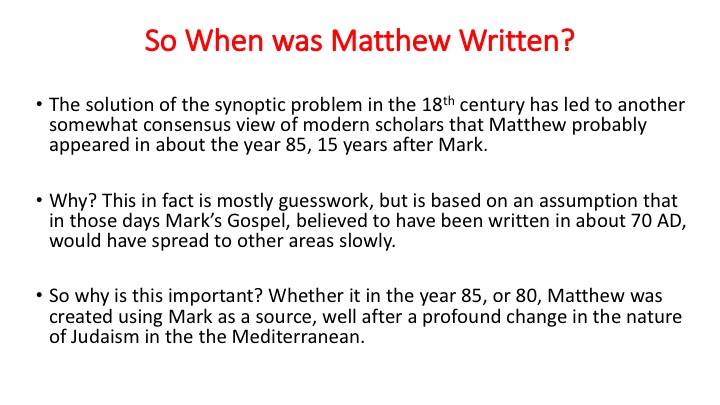
So When was Matthew Written?
The solution of the synoptic problem in the 18th century has led to another somewhat consensus view of modern scholars that Matthew probably appeared in about the year 85, 15 years after Mark.
Why? This in fact is mostly guesswork, but is based on an assumption that in those days Mark’s Gospel, believed to have been written in about 70 would spread to other areas slowly.
So why is this important? Whether it in the year 85, or 80, Matthew was probably created using Mark as a source, well after a profound change in the nature of Judaism.
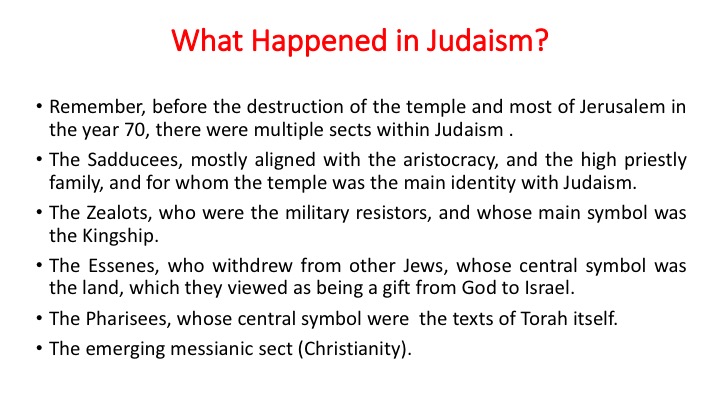
Jesus and the Gospels
What Happened in Judaism
Remember, before the destruction of the temple and most of Jerusalem in the year 70, there were multiple sects within Judaism .
1. The Sadducees, mostly aligned with the aristocracy, and the high priestly family, and for whom the temple was the main identity with Judaism.
2. The Zealots, who were the military resistors, and whose main symbol was the Kingship.
3. The Essenes, who withdrew from other Jews, whose central symbol was the land, which they viewed as being a gift from God to Israel.
4. The Pharisees, whose central symbol were the texts of Torah itself.
5. The emerging messianic sect (Christianity).
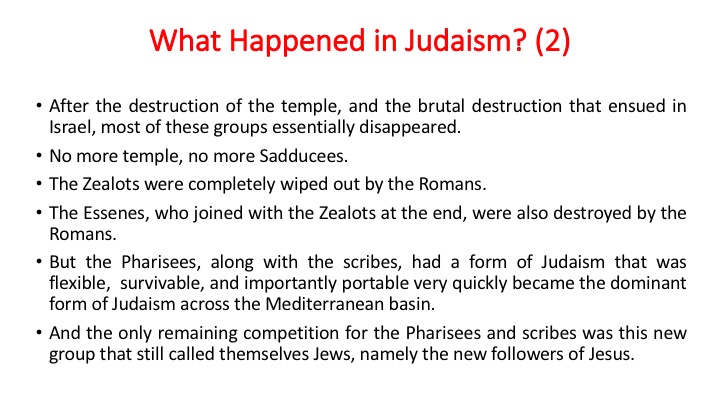
What Happened to Judaism (2)
After the destruction of the temple, and the brutal destruction that ensued in Israel, most of these groups essentially disappeared.
No more temple, no more Sadducees.
The Zealots were completely wiped out by the Romans.
The Essenes, who joined with the Zealots at the end, were also destroyed by the Romans.
But the Pharisees , who had a form of Judaism that was flexible, survivable, and importantly portable very quickly became the dominant form of Judaism
And the only remaining competition for Pharisees was this new group that still called themselves Jews, namely the new followers of Jesus.
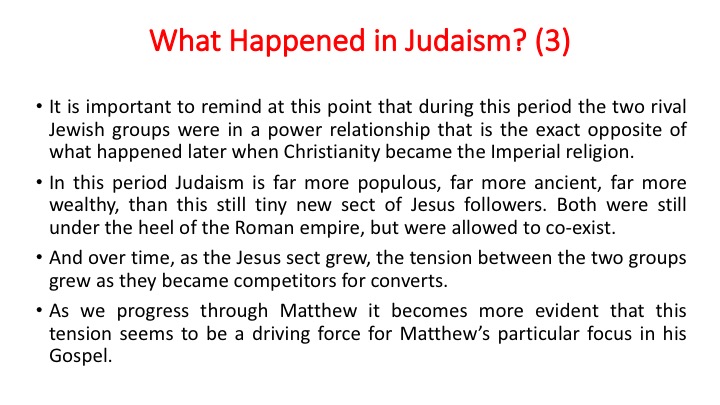
What Happened in Judaism (3)
It is important to remind at this point that during this period that the the two rival Jewish groups were in a power relationship that is the exact opposite of what happened later when Christianity became the Imperial religion.
In this period Judaism is far more populous, far more ancient, far more wealthy, than this still tiny new sect of Jesus followers. Both were still under the heel of the Roman empire, but were allowed to co-exist.
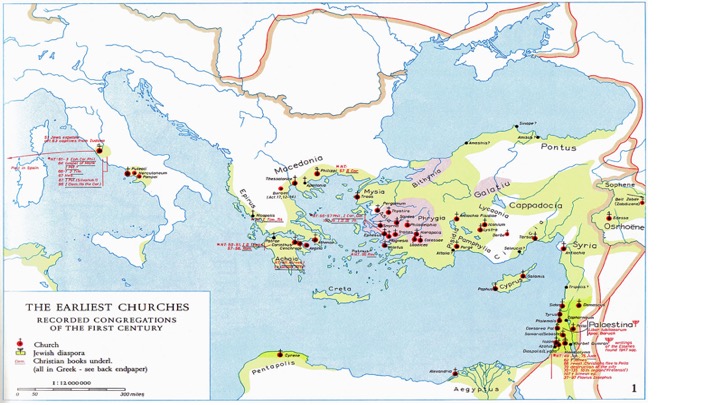
The Map
Let's take a quick look at the map we used before to remind us of the situation. Remember this map reflects conditions in about the year 64. So the rapid expansion of Christian churches was underway. And they all were surrounded by the Jews of the Diaspora. And as far as we know many of these early Christians were still worshipping in Jewish synagogues as well as in house churches.
Matthew's Gospel, if written in about the year 85, reflects a situation in which the Christians were more and more Gentiles and increasingly in competition with the predominant and still growing Jewish sect that was Pharisaic in its practices. We are not completely sure which of these communities Matthew came from but we will see from his story line that it was probably one in which the tension between the two sects of Judaism were in tension.
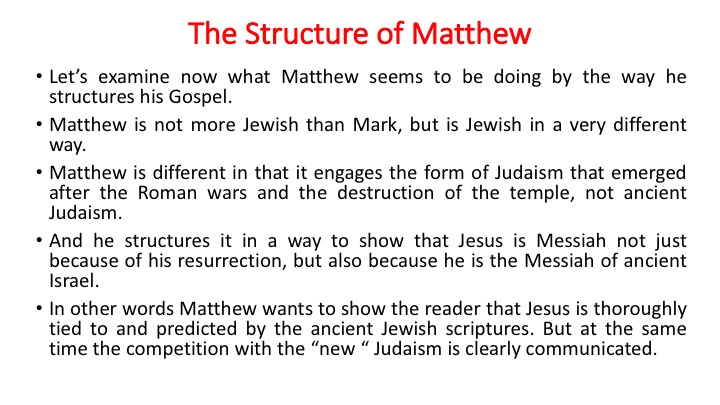
The Structure of Matthew - Jesus and the Gospels
Let’s examine now what Matthew seems to be doing by the way he structures his Gospel.
Matthew is not more Jewish than Mark, but is Jewish in a very different way.
It is different in that it engages the form of Judaism that emerged after the Roman wars and the destruction of the temple.
And he structures it in a way to show that Jesus is Messiah not just because of his resurrection, but also because he is the Messiah of Israel.
In other words Matthew wants to show the reader that Jesus is thoroughly tied to and predicted by the ancient Jewish scriptures.
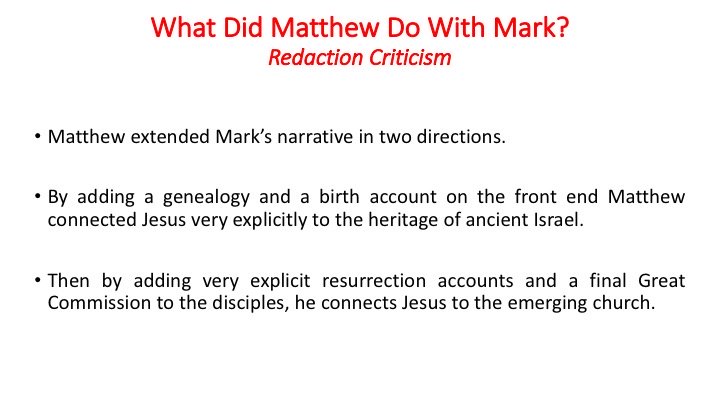
Gospel of Matthew – Jesus and Torah
Matthew extended Mark’s narrative in two directions. Backward in time and forward in time.
By adding a genealogy and a birth account on the front end Matthew connected Jesus very explicitly to the heritage of ancient Israel.
Then by adding very explicit resurrection accounts and a final commission to the disciples, he connects Jesus to the emerging and growing church.
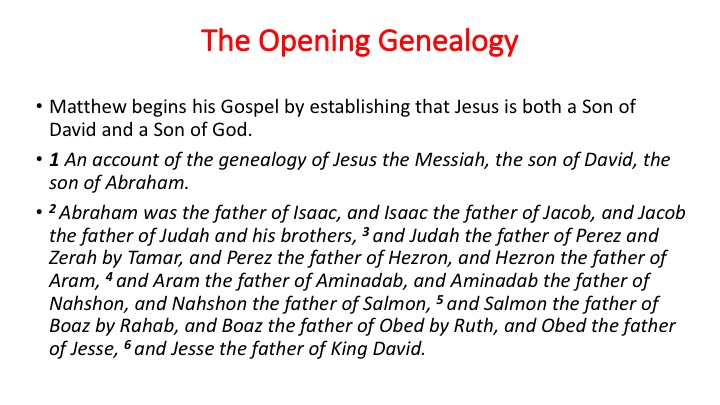
The Opening Geneology
Matthew begins his Gospel by establishing that Jesus is both a Son of David and a Son of God.
Matthew 1
1 An account of the genealogy of Jesus the Messiah, the son of David, the son of Abraham.
2 Abraham was the father of Isaac, and Isaac the father of Jacob, and Jacob the father of Judah and his brothers, 3 and Judah the father of Perez and Zerah by Tamar, and Perez the father of Hezron, and Hezron the father of Aram, 4 and Aram the father of Aminadab, and Aminadab the father of Nahshon, and Nahshon the father of Salmon, 5 and Salmon the father of Boaz by Rahab, and Boaz the father of Obed by Ruth, and Obed the father of Jesse, 6 and Jesse the father of King David.

The Opening Genealogy (2)
And Matthew’s genealogy continues for 17 verses before summarizing:
17 So all the generations from Abraham to David are fourteen generations; and from David to the deportation to Babylon, fourteen generations; and from the deportation to Babylon to the Messiah, fourteen generations.
Notice the careful construction of the generations – 14, 14, and 14. – probably a device to indicate divine planning.
Matthew shows us that Jesus descended all the way from Abraham and is thus thoroughly Jewish.
Secondly Jesus is descended from David, so David is the pivotal figure in the genealogy and therefore Jesus belongs to the Davidic line of Kingship within Israel.
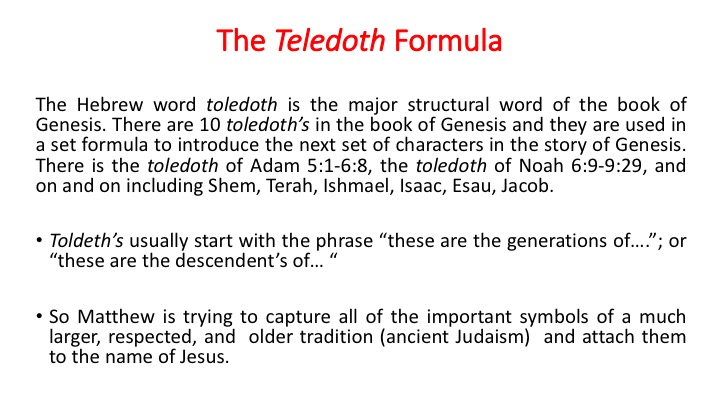
Jesus and the Gospels
The Toledoth Formula
The Hebrew word toledoth is the major structural word of the book of Genesis. There are 10 toledoth’s in the book of Genesis and they are used in a set formula to introduce the next set of characters in the story of Genesis. There is the toledoth of Adam 5:1-6:8, the toledoth of Noah 6:9-9:29, and on and on including Shem, Terah, Ishmael, Isaac, Esau, Jacob, etc.
Toldeth’s usually start with the phrase “these are the generations of….”; or “these are the descendent’s of… “. They are basically genealogies.
What is the significance of this? Matthew is trying to capture all of the important symbols of a much larger, respected and older tradition (ancient Judaism) and attach them to the name of Jesus. Just like all of the important characters in Genesis, Jesus is being introduced by a Toledoth.
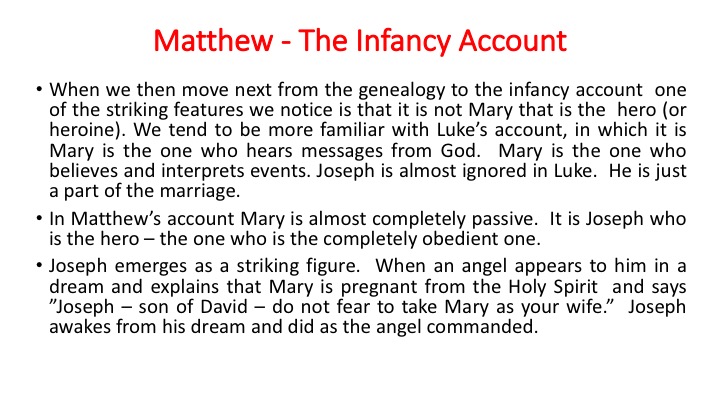
Matthew - The Infancy Account
When we then move next from the genealogy to the infancy account one of the striking features we notice is that it is not Mary that is the hero (or heroine). We tend to be more familiar with Luke’s account, in which it is Mary is the one who hears messages from God. Mary is the one who believes and interprets events. Joseph is almost ignored in Luke. He is just a part of the marriage.
In Matthew’s account Mary is almost completely passive. It is Joseph who is the hero – the one who is the completely obedient one.
Joseph emerges as a striking figure. When an angel appears to him in a dream and explains that Mary is pregnant from the Holy Spirit and says ”Joseph – son of David – do not fear to take Mary as your wife.” Joseph awakes from his dream and did as the angel commanded.
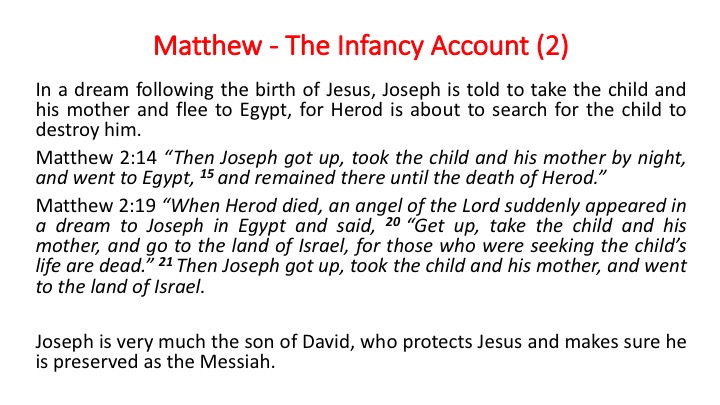
Matthew - The Infancy Account (2)
In a dream following the birth of Jesus, Joseph is told to take the child and his Mother and fllee to Egypt, for Herod is about to search for th child and destroy him.
Matthew 2:14 "Then Joseph got up, took the child and his mother by night, and went to Egypt, and remained there until the death of Herod."
Matthew 2:19 "When Herod died, an angel of the Lord suddenly appeared in a dream to Joseph in Egypt and said "Get up, take the child and his mother, and go to the land of Israel, for those who wre seeking the child's life are dead. then Joseph got up, took the child and his mother, and went to the land of Israel.
Joseph is very much the son of David, who protects Jesus and makes sure he is preserved as the Messiah.
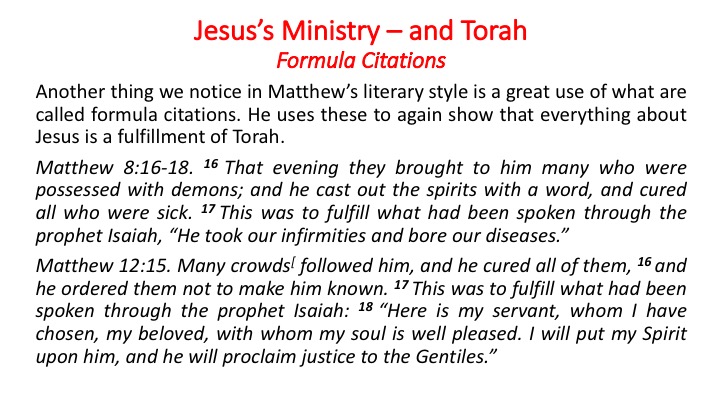
Jesus’s Ministry – and Torah
Formula Citations
Another thing we notice in Matthew’s literary style is a great use of what are called formula Citations
Matthew 8:16-18. 16 That evening they brought to him many who were possessed with demons; and he cast out the spirits with a word, and cured all who were sick. 17 This was to fulfill what had been spoken through the prophet Isaiah, “He took our infirmities and bore our diseases.”
Matthew 12:15. Many crowds[ followed him, and he cured all of them, 16 and he ordered them not to make him known. 17 This was to fulfill what had been spoken through the prophet Isaiah:
18 “Here is my servant, whom I have chosen, my beloved, with whom my soul is well pleased. I will put my Spirit upon him, and he will proclaim justice to the Gentiles.”

The Infancy Account – and Torah
More Formula Citations
In Chapter 13, whenever Jesus tells parables, Matthew explains that he tells parables so that people will not understand.
Matthew 13:14-15. 14 With them indeed is fulfilled the prophecy of Isaiah that says: ‘You will indeed listen, but never understand, and you will indeed look, but never perceive. 15 For this people’s heart has grown dull, and their ears are hard of hearing, and they have shut their eyes;
And in describing Jesus’s triumphal entry into Jerusalem in chapter 21, Matthew quotes the prophet Zachariah.
Matthew 21:
3 If
anyone says anything to you, just say this, ‘The Lord needs them.’ And he will
send them immediately.” 4 This took place to fulfill what had
been spoken through the prophet, saying, 5 “Tell the daughter of Zion, Look,
your king is coming to you, humble, and mounted on a donkey,
and on a colt, the foal of a donkey.”
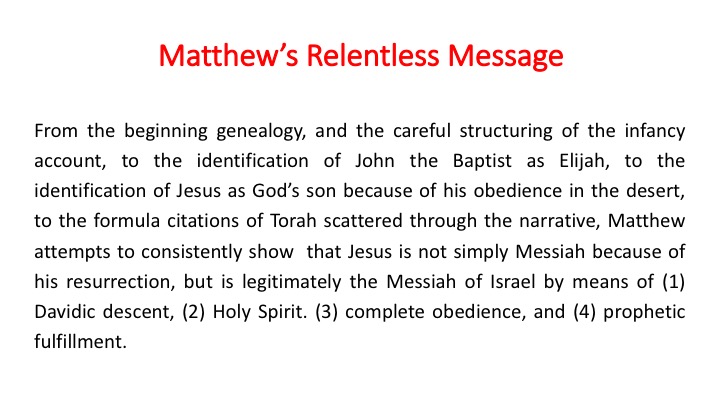
Jesus and the Gospels
Matthew’s Relentless Message
From the beginning genealogy, and the careful structuring of the infancy account, to the identification of John the Baptist as Elijah. To the identification of Jesus as God’s son because of his obedience in the desert, to the formula citations of Torah scattered through the narrative, Matthew attempts to consistently show that Jesus is not simply Messiah because of his resurrection, but is legitimately the Messiah of Israel by means of (1) Davidic descent, (2) Holy Spirit. (3) complete obedience, and (4) prophetic fulfillment.
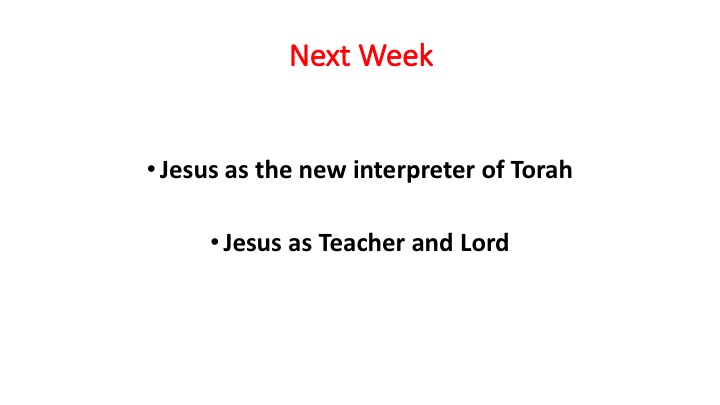
Next Week
Jesus as the new interpreter of Torah
Jesus as Teacher and Lord